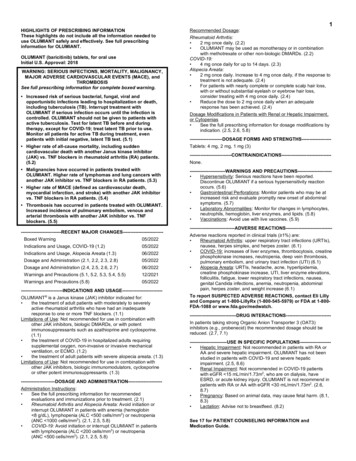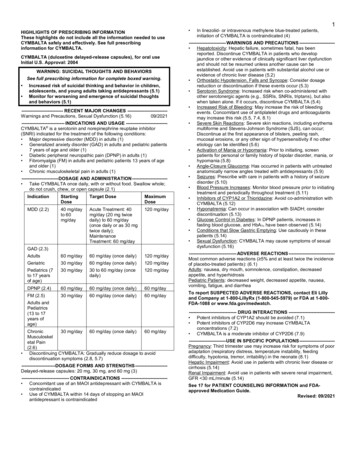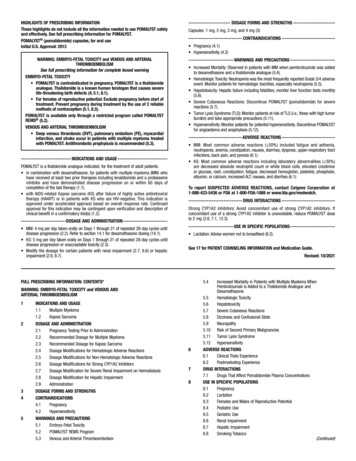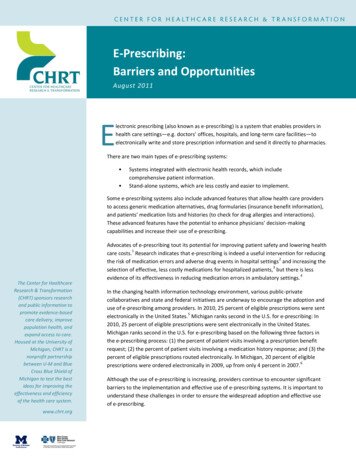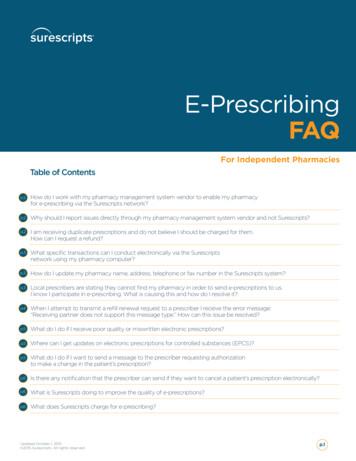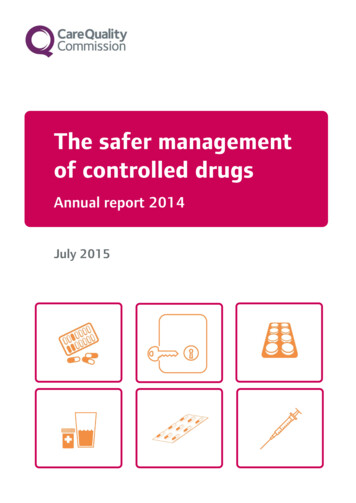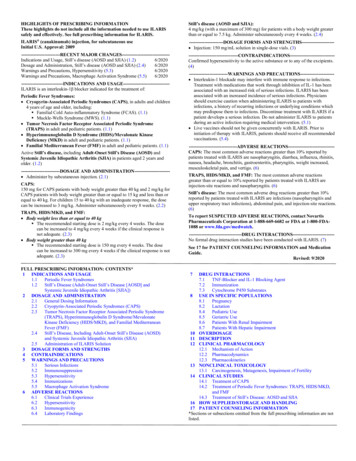
Transcription
HIGHLIGHTS OF PRESCRIBING INFORMATIONThese highlights do not include all the information needed to use ILARISsafely and effectively. See full prescribing information for ILARIS.Still’s disease (AOSD and SJIA):4 mg/kg (with a maximum of 300 mg) for patients with a body weight greaterthan or equal to 7.5 kg. Administer subcutaneously every 4 weeks. (2.4)ILARIS (canakinumab) injection, for subcutaneous useInitial U.S. Approval: 2009----------------------DOSAGE FORMS AND STRENGTHS-------------------- Injection: 150 mg/mL solution in single-dose vials. (3)-------------------------RECENT MAJOR CHANGES------------------------------Indications and Usage, Still’s disease (AOSD and SJIA) (1.2)6/2020Dosage and Administration, Still’s disease (AOSD and SJIA) (2.4)6/2020Warnings and Precautions, Hypersensitivity (5.3)6/2020Warnings and Precautions, Macrophage Activation Syndrome NDICATIONS----------------------------Confirmed hypersensitivity to the active substance or to any of the NS AND USAGE-----------------------------ILARIS is an interleukin-1β blocker indicated for the treatment of:Periodic Fever Syndromes: Cryopyrin-Associated Periodic Syndromes (CAPS), in adults and children4 years of age and older, including: Familial Cold Auto-inflammatory Syndrome (FCAS). (1.1) Muckle-Wells Syndrome (MWS). (1.1) Tumor Necrosis Factor Receptor Associated Periodic Syndrome(TRAPS) in adult and pediatric patients. (1.1) Hyperimmunoglobulin D Syndrome (HIDS)/Mevalonate KinaseDeficiency (MKD) in adult and pediatric patients. (1.1) Familial Mediterranean Fever (FMF) in adult and pediatric patients. (1.1)Active Still’s disease, including Adult-Onset Still’s Disease (AOSD) andSystemic Juvenile Idiopathic Arthritis (SJIA) in patients aged 2 years andolder. (1.2)-------------------------DOSAGE AND ADMINISTRATION---------------------- Administer by subcutaneous injection. (2.1)CAPS:150 mg for CAPS patients with body weight greater than 40 kg and 2 mg/kg forCAPS patients with body weight greater than or equal to 15 kg and less than orequal to 40 kg. For children 15 to 40 kg with an inadequate response, the dosecan be increased to 3 mg/kg. Administer subcutaneously every 8 weeks. (2.2)TRAPS, HIDS/MKD, and FMF: Body weight less than or equal to 40 kg The recommended starting dose is 2 mg/kg every 4 weeks. The dosecan be increased to 4 mg/kg every 4 weeks if the clinical response isnot adequate. (2.3) Body weight greater than 40 kg The recommended starting dose is 150 mg every 4 weeks. The dosecan be increased to 300 mg every 4 weeks if the clinical response is notadequate. (2.3)FULL PRESCRIBING INFORMATION: CONTENTS*1 INDICATIONS AND USAGE1.1Periodic Fever Syndromes1.2Still’s Disease (Adult-Onset Still’s Disease [AOSD] andSystemic Juvenile Idiopathic Arthritis [SJIA])2 DOSAGE AND ADMINISTRATION2.1General Dosing Information2.2Cryopyrin-Associated Periodic Syndromes (CAPS)2.3Tumor Necrosis Factor Receptor Associated Periodic Syndrome(TRAPS), Hyperimmunoglobulin D Syndrome/MevalonateKinase Deficiency (HIDS/MKD), and Familial MediterraneanFever (FMF)2.4Still’s Disease, Including Adult-Onset Still’s Disease (AOSD)and Systemic Juvenile Idiopathic Arthritis (SJIA)2.5Administration of ILARIS Solution3 DOSAGE FORMS AND STRENGTHS4 CONTRAINDICATIONS5 WARNINGS AND PRECAUTIONS5.1Serious .4Immunizations5.5Macrophage Activation Syndrome6 ADVERSE REACTIONS6.1Clinical Trials aboratory Findings-------------------------WARNINGS AND PRECAUTIONS--------------------- Interleukin-1 blockade may interfere with immune response to infections.Treatment with medications that work through inhibition of IL-1 has beenassociated with an increased risk of serious infections. ILARIS has beenassociated with an increased incidence of serious infections. Physiciansshould exercise caution when administering ILARIS to patients withinfections, a history of recurring infections or underlying conditions whichmay predispose them to infections. Discontinue treatment with ILARIS if apatient develops a serious infection. Do not administer ILARIS to patientsduring an active infection requiring medical intervention. (5.1) Live vaccines should not be given concurrently with ILARIS. Prior toinitiation of therapy with ILARIS, patients should receive all recommendedvaccinations. (5.4)-------------------------------ADVERSE REACTIONS-----------------------------CAPS: The most common adverse reactions greater than 10% reported bypatients treated with ILARIS are nasopharyngitis, diarrhea, influenza, rhinitis,nausea, headache, bronchitis, gastroenteritis, pharyngitis, weight increased,musculoskeletal pain, and vertigo. (6)TRAPS, HIDS/MKD, and FMF: The most common adverse reactionsgreater than or equal to 10% reported by patients treated with ILARIS areinjection-site reactions and nasopharyngitis. (6)Still’s disease: The most common adverse drug reactions greater than 10%reported by patients treated with ILARIS are infections (nasopharyngitis andupper respiratory tract infections), abdominal pain, and injection-site reactions.(6)To report SUSPECTED ADVERSE REACTIONS, contact NovartisPharmaceuticals Corporation at 1-888-669-6682 or FDA at 1-800-FDA1088 or -----DRUG INTERACTIONS--------------------------No formal drug interaction studies have been conducted with ILARIS. (7)See 17 for PATIENT COUNSELING INFORMATION and MedicationGuide.Revised: 9/20207DRUG INTERACTIONS7.1TNF-Blocker and IL-1 Blocking Agent7.2Immunization7.3Cytochrome P450 Substrates8 USE IN SPECIFIC POPULATIONS8.1Pregnancy8.2Lactation8.4Pediatric Use8.5Geriatric Use8.6Patients With Renal Impairment8.7Patients With Hepatic Impairment10 OVERDOSAGE11 DESCRIPTION12 CLINICAL PHARMACOLOGY12.1 Mechanism of Action12.2 Pharmacodynamics12.3 Pharmacokinetics13 NONCLINICAL TOXICOLOGY13.1 Carcinogenesis, Mutagenesis, Impairment of Fertility14 CLINICAL STUDIES14.1 Treatment of CAPS14.2 Treatment of Periodic Fever Syndromes: TRAPS, HIDS/MKD,and FMF14.3 Treatment of Still’s Disease: AOSD and SJIA16 HOW SUPPLIED/STORAGE AND HANDLING17 PATIENT COUNSELING INFORMATION*Sections or subsections omitted from the full prescribing information are notlisted.
FULL PRESCRIBING INFORMATION11.1INDICATIONS AND USAGEPeriodic Fever Syndromes ILARIS (canakinumab) is an interleukin-1β (IL-1β) blocker indicated for the treatment of the followingautoinflammatory Periodic Fever Syndromes:Cryopyrin-Associated Periodic Syndromes (CAPS)ILARIS is indicated for the treatment of Cryopyrin-Associated Periodic Syndromes (CAPS), in adults and children 4years of age and older, including: Familial Cold Autoinflammatory Syndrome (FCAS) Muckle-Wells Syndrome (MWS)Tumor Necrosis Factor Receptor (TNF) Associated Periodic Syndrome (TRAPS)ILARIS is indicated for the treatment of Tumor Necrosis Factor (TNF) Receptor Associated Periodic Syndrome (TRAPS)in adult and pediatric patients.Hyperimmunoglobulin D Syndrome (HIDS)/Mevalonate Kinase Deficiency (MKD)ILARIS is indicated for the treatment of Hyperimmunoglobulin D (Hyper-IgD) Syndrome (HIDS)/Mevalonate KinaseDeficiency (MKD) in adult and pediatric patients.Familial Mediterranean Fever (FMF)ILARIS is indicated for the treatment of Familial Mediterranean Fever (FMF) in adult and pediatric patients.1.2Still’s Disease (Adult-Onset Still’s Disease [AOSD] and Systemic Juvenile Idiopathic Arthritis [SJIA])ILARIS is indicated for the treatment of active Still’s disease, including Adult-Onset Still’s Disease (AOSD) andSystemic Juvenile Idiopathic Arthritis (SJIA) in patients aged 2 years and older.2DOSAGE AND ADMINISTRATION2.1General Dosing InformationINJECTION FOR SUBCUTANEOUS USE ONLY.2.2Cryopyrin-Associated Periodic Syndromes (CAPS)The recommended dose of ILARIS is 150 mg for CAPS patients with body weight greater than 40 kg. For CAPS patientswith body weight greater than or equal to 15 kg and less than or equal to 40 kg, the recommended dose is 2 mg/kg. Forchildren 15 to 40 kg with an inadequate response, the dose can be increased to 3 mg/kg.ILARIS is administered every 8 weeks.2.3Tumor Necrosis Factor Receptor Associated Periodic Syndrome (TRAPS), Hyperimmunoglobulin DSyndrome/Mevalonate Kinase Deficiency (HIDS/MKD), and Familial Mediterranean Fever (FMF)The recommended dose of ILARIS for TRAPS, HIDS/MKD, and FMF patients is based on body weight.For patients with body weight less than or equal to 40 kg, the recommended dose is 2 mg/kg administered every 4 weeks.The dose can be increased to 4 mg/kg every 4 weeks if the clinical response is not adequate.For patients with body weight greater than 40 kg, the recommended dose is 150 mg administered every 4 weeks. The dosecan be increased to 300 mg every 4 weeks if the clinical response is not adequate.2.4Still’s Disease, Including Adult-Onset Still’s Disease (AOSD) and Systemic Juvenile Idiopathic Arthritis(SJIA)The recommended dose of ILARIS for patients with Still’s disease (AOSD and SJIA) with a body weight greater than orequal to 7.5 kg is 4 mg/kg (with a maximum of 300 mg) administered every 4 weeks.
2.5Administration of ILARIS SolutionSTEP 1: ILARIS solution has a concentration of 150 mg/mL. Do not shake. The solution should be essentially free fromparticulates, clear to opalescent, colorless to slightly brownish-yellow tint. If the solution has a distinctly browndiscoloration, is highly opalescent or contains visible particles, do not use.STEP 2: Using a sterile 1-mL syringe and 18-gauge x 2” needle, carefully withdraw the required volume depending onthe dose to be administered and subcutaneously inject using a 27-gauge x 0.5” needle.Injection into scar tissue should be avoided as this may result in insufficient exposure to ILARIS.Discard unused product or waste material in accordance with the local requirements.3DOSAGE FORMS AND STRENGTHSInjection: 150 mg/mL solution in single-dose vials. The solution is a clear to slightly opalescent, colorless to a slightlybrownish yellow tint.4CONTRAINDICATIONSConfirmed hypersensitivity to the active substance or to any of the excipients [see Warnings and Precautions (5.3) andAdverse Reactions (6.2)].5WARNINGS AND PRECAUTIONS5.1Serious InfectionsILARIS has been associated with an increased risk of serious infections. Physicians should exercise caution whenadministering ILARIS to patients with infections, a history of recurring infections or underlying conditions which maypredispose them to infections. ILARIS should not be administered to patients during an active infection requiring medicalintervention. Administration of ILARIS should be discontinued if a patient develops a serious infection.Infections, predominantly of the upper respiratory tract, in some instances serious, have been reported with ILARIS.Generally, the observed infections responded to standard therapy. Isolated cases of unusual or opportunistic infections(e.g., aspergillosis, atypical mycobacterial infections, cytomegalovirus, herpes zoster) were reported during ILARIStreatment. A causal relationship of ILARIS to these events cannot be excluded. In clinical trials, ILARIS has not beenadministered concomitantly with tumor necrosis factor (TNF) inhibitors. An increased incidence of serious infections hasbeen associated with administration of another IL-1 blocker in combination with TNF inhibitors. Coadministration ofILARIS with TNF inhibitors is not recommended because this may increase the risk of serious infections [see DrugInteractions (7.1)].Drugs that affect the immune system by blocking TNF have been associated with an increased risk of new tuberculosisand reactivation of latent tuberculosis (TB). It is possible that use of IL-1 inhibitors, such as ILARIS, increases the risk ofreactivation of tuberculosis or of opportunistic infections.Prior to initiating immunomodulatory therapies, including ILARIS, patients should be evaluated for active and latenttuberculosis infection. Appropriate screening tests should be performed in all patients. ILARIS has not been studied inpatients with a positive tuberculosis screen, and the safety of ILARIS in individuals with latent tuberculosis infection isunknown. Patients testing positive in tuberculosis screening should be treated according to standard medical practice priorto therapy with ILARIS. All patients should be instructed to seek medical advice if signs, symptoms, or high risk exposuresuggestive of tuberculosis (e.g., persistent cough, weight loss, subfebrile temperature) appear during or after ILARIStherapy.Healthcare providers should follow current CDC guidelines both to evaluate for and to treat possible latent tuberculosisinfections before initiating therapy with ILARIS.5.2ImmunosuppressionThe impact of treatment with anti-interleukin-1 (IL-1) therapy on the development of malignancies is not known.However, treatment with immunosuppressants, including ILARIS, may result in an increase in the risk of malignancies.
5.3HypersensitivityHypersensitivity reactions have been reported with ILARIS therapy. During clinical trials, no anaphylactic reactionsattributable to treatment with canakinumab have been reported. It should be recognized that symptoms of the underlyingdisease being treated may be similar to symptoms of hypersensitivity. ILARIS should not be administered to any patientswith known clinical hypersensitivity to ILARIS. If a severe hypersensitivity reaction occurs, administration of ILARISshould be discontinued and appropriate therapy initiated [see Contraindications (4) and Adverse Reactions (6.2)].5.4ImmunizationsLive vaccines should not be given concurrently with ILARIS [see Drug Interactions (7.2)]. Since no data are available oneither the efficacy or on the risks of secondary transmission of infection by live vaccines in patients receiving ILARIS,live vaccines should not be given concurrently with ILARIS. In addition, because ILARIS may interfere with normalimmune response to new antigens, vaccinations may not be effective in patients receiving ILARIS. Limited data areavailable on the response to vaccinations with inactivated (killed) antigens in patients receiving ILARIS [see DrugInteractions (7.2)].Because IL-1 blockade may interfere with immune response to infections, it is recommended that prior to initiation oftherapy with ILARIS, adult and pediatric patients receive all recommended vaccinations, as appropriate and if feasible,including pneumococcal vaccine and inactivated influenza vaccine. See current recommended immunization schedules atthe website of the Centers for Disease Control, .5Macrophage Activation SyndromeMacrophage activation syndrome (MAS) is a known, life-threatening disorder that may develop in patients with rheumaticconditions, in particular Still’s disease, and should be aggressively treated. Physicians should be attentive to symptoms ofinfection or worsening of Still’s disease, as these are known triggers for MAS. Eleven cases of MAS were observed in201 SJIA patients treated with canakinumab in clinical trials. Based on the clinical trial experience, ILARIS does notappear to increase the incidence of MAS in Still’s disease patients, but no definitive conclusion can be made.6ADVERSE REACTIONSIn patients who have been treated with ILARIS in interventional trials in CAPS, TRAPS, HIDS/MKD, FMF or Still’sdisease, the most frequently reported adverse drug reactions were infections predominantly of the upper respiratory tract.The majority of the events were mild to moderate although serious infections were observed.Opportunistic infections have also been reported in patients treated with ILARIS [see Warnings and Precautions (5.1)].6.1Clinical Trials ExperienceBecause clinical trials are conducted under widely varying conditions, adverse reaction rates observed in the clinical trialsof a drug cannot be directly compared to rates in the clinical trials of another drug and may not reflect the rates observedin practice.Treatment of Periodic Fever Syndromes: CAPS, TRAPS, HIDS/MKD, and FMFTreatment of CAPSThe data described herein reflect exposure to ILARIS in 104 adult and pediatric CAPS patients, including 20 FCAS, 72MWS, 10 MWS/NOMID (Neonatal Onset Multisystem Inflammatory Disorder) overlap, 1 non-FCAS non-MWS, and 1misdiagnosed in placebo-controlled (35 patients) and uncontrolled trials. Sixty-two patients were exposed to ILARIS forat least 6 months, 56 for at least 1 year, and 4 for at least 3 years. A total of 9 serious adverse reactions were reported forCAPS patients. Among these were vertigo (2 patients), infections (3 patients), including intra-abdominal abscessfollowing appendectomy (1 patient). The most commonly reported adverse reactions associated with ILARIS treatment ingreater than 10% of the CAPS patients were nasopharyngitis, diarrhea, influenza, rhinitis, nausea, headache, bronchitis,gastroenteritis, pharyngitis, weight increased, musculoskeletal pain, and vertigo. One patient discontinued treatment dueto potential infection.CAPS Study 1 investigated the safety of ILARIS in an 8-week, open-label period (Part 1), followed by a 24-week,randomized withdrawal period (Part 2), followed by a 16-week, open-label period (Part 3). All patients were treated withILARIS 150 mg subcutaneously or 2 mg/kg if body weight was greater than or equal to 15 kg and less than or equal to 40kg (see Table 1).
Since all CAPS patients received ILARIS in Part 1, there are no controlled data on adverse events (AEs). Data in Table 1are for all AEs for all CAPS patients receiving canakinumab. In CAPS Study 1, no pattern was observed for any type orfrequency of adverse events throughout the three study periods.Table 1: Number (%) of Patients With AEs by Preferred Terms, in Greater Than 10% of Patients in Parts 1 to 3 ofthe Phase 3 Trial for CAPS PatientsPreferred Termn % of Patients with Adverse ht increasedMusculoskeletal painVertigoILARISN 35n (%)35 (100)12 (34)7 (20)6 (17)6 (17)5 (14)5 (14)4 (11)4 (11)4 (11)4 (11)4 (11)4 (11)VertigoVertigo has been reported in 9% to 14% of patients in CAPS studies, exclusively in MWS patients, and reported as aserious adverse event in two cases. All events resolved with continued treatment with ILARIS.Injection-Site ReactionsIn CAPS Study 1, subcutaneous injection-site reactions were observed in 9% of patients in Part 1 with mild tolerabilityreactions; in Part 2, one patient each (7%) had a mild or a moderate tolerability reaction and, in Part 3, one patient had amild local tolerability reaction. No severe injection-site reactions were reported and none led to discontinuation oftreatment.Treatment of TRAPS, HIDS/MKD, and FMFA phase III trial (TRAPS, HIDS/MKD, and FMF Study 1) investigated the safety of ILARIS in 3 cohorts (TRAPS,HIDS/MKD, and FMF) as follows: a 12-week screening period (Part 1), followed by a 16-week, randomized, doubleblind, placebo-controlled parallel-arm treatment period (Part 2), followed by a 24-week randomized withdrawal period(Part 3), followed by a 72-week, open-label treatment period (Part 4). All patients randomized to treatment with ILARISin Part 2 received 150 mg subcutaneously every 4 weeks if body weight was greater than 40 kg (or 2 mg/kg every 4 weeksif body weight was less than or equal to 40 kg).In Part 2 of the TRAPS, HIDS/MKD, and FMF Study 1, initially 90 patients were randomized to ILARIS treatment and91 patients were randomized to placebo. Of patients randomized to ILARIS, 55.6% remained on the initial dose throughWeek 16 with 6.7% receiving an additional ILARIS dose between Day 7 and Day 15. Of the patients randomized toplacebo, 9.9% remained on placebo through Week 16 with 28.6% switching to active treatment with ILARIS by Day 15.Overall, there were 43 TRAPS, 68 HIDS/MKD, and 58 FMF patients in the safety set with a cumulative canakinumabexposure of 47.61 patient-years. The cumulative exposure in the placebo group was 8.03 patient-years.In Part 2 of the TRAPS, HIDS/MKD, and FMF Study 1, a total of 22 TRAPS patients aged 3 to 76 years of age, 37HIDS/MKD patients aged 2 to 43 years of age, and 31 FMF patients aged 2 to 60 years of age were initially randomizedto treatment with ILARIS 150 mg every four weeks in the placebo-controlled period of the clinical trial. In addition, 4non-randomized patients (2 FMF patients of age 20 and 29 years with non-exon 10 mutations and 2 HIDS/MKD patientsboth of 1 year of age) received open-label treatment in Part 2.
The most commonly reported adverse reactions (greater than or equal to 10%) associated with ILARIS treatment inTRAPS, HIDS/MKD, and FMF patients were injection-site reactions and nasopharyngitis. The reported adverse reactions(greater than or equal to 3%) associated with ILARIS treatment in TRAPS, HIDS/MKD, and FMF patients were injectionsite reactions (10.1%), and infections, including nasopharyngitis (10.7%), upper respiratory tract infection (7.1%), rhinitis(5.3%), gastroenteritis (3.0%), and pharyngitis (3.0%). Serious infections (e.g., conjunctivitis, pneumonia, pharyngitis,pharyngotonsillitis) were observed in approximately 2.4% (0.03 per 100 patient-days) of patients receiving ILARIS inPart 2 of the TRAPS, HIDS/MKD, and FMF Study 1.In the ILARIS treatment group, 1 TRAPS patient discontinued treatment due to adverse events, 2 HIDS/MKD patientsdiscontinued treatment due to adverse events, and no FMF patients discontinued treatment due to an adverse event.Injection-Site ReactionsIn the TRAPS, HIDS/MKD, and FMF Study 1, subcutaneous injection-site reactions were observed in 10.1% of patientsin Part 2 who had a mild or a moderate tolerability reaction. No severe injection-site reactions were reported and none ledto discontinuation of treatment.Treatment of Still’s disease: SJIA and AOSDThe safety of ILARIS compared to placebo in SJIA patients was investigated in two phase 3 studies [see Clinical Studies(14.2)]. Patients in SJIA Study 1 received a single dose of ILARIS 4 mg/kg (n 43) or placebo (n 41) via subcutaneousinjection and were assessed at Day 15 for the efficacy endpoints and had a safety analysis up to Day 29. SJIA Study 2 wasa two-part study with an open-label, single-arm active treatment period (Part I) followed by a randomized, double-blind,placebo-controlled, event-driven withdrawal design (Part II). Overall, 177 patients were enrolled into the study andreceived ILARIS 4 mg/kg (up to 300 mg maximum) in Part I, and 100 patients received ILARIS 4 mg/kg (up to 300 mgmaximum) every 4 weeks or placebo in Part II. Adverse drug reactions listed in Table 2 showed higher rates than placebofrom both trials. The adverse drug reactions associated with ILARIS treatment in greater than 10% of SJIA patients wereinfections, abdominal pain, and injection-site reactions. Serious infections (e.g., pneumonia, varicella, gastroenteritis,measles, sepsis, otitis media, sinusitis, adenovirus, lymph node abscess, pharyngitis) were observed in approximately 4%to 5% (0.02 to 0.17 per 100 patient-days) of patients receiving ILARIS in both studies.Adverse reactions are listed according to MedDRA version 15.0 system organ class.Table 2: Tabulated Summary of Adverse Drug Reactions From Pivotal SJIA Clinical TrialsSJIA Study 2Infections and infestationsAll Infections (e.g.,nasopharyngitis, [viral] upperrespiratory tract infection,pneumonia, rhinitis, pharyngitis,tonsillitis, sinusitis, urinary tractinfection, gastroenteritis, viralinfection)Gastrointestinal disordersAbdominal pain (upper)SJIA Study 1Part IILARISN 177n (%)(IR) ILARISN 50n (%)(IR)97 (54.8%)(0.91)27 (54%)(0.59)19 (38%)(0.63)13 (30.2%)(1.26)5 (12.2%)(1.37)8 (16%)(0.15)6 (12%)(0.08)3 (7%)(0.25)1 (2.4%)(0.23)6 (12.0%)1 (2.0%)2 (4.0%)0003 (7.3%)025 (14.1%)(0.16)Skin and subcutaneous tissue disordersInjection-site reaction*mild19 (10.7%)moderate2 (1.1%)n number of patients. IR Exposure adjusted incidence rate per 100 patient-days.*No injection-site reaction led to study discontinuation.Part IIPlaceboN 50n (%)(IR)ILARISN 43n (%)(IR)PlaceboN 41n (%)(IR)
The safety profile of ILARIS in AOSD patients in a randomized, double-blind, placebo-controlled study (GDE01T) in 36adult patients (aged 22 to 70 years) was similar to what was observed in SJIA patients.6.2HypersensitivityDuring clinical trials, no anaphylactic reactions attributable to treatment with canakinumab have been reported. In CAPStrials one patient discontinued and in TRAPS, HIDS/MKD, FMF, and Still’s disease trials no patients discontinued due tohypersensitivity reactions. ILARIS should not be administered to any patients with known clinical hypersensitivity toILARIS [see Contraindications (4) and Warnings and Precautions (5.3)].6.3ImmunogenicityA biosensor binding assay or a bridging immunoassay was used to detect antibodies directed against canakinumab inpatients who received ILARIS. Antibodies against ILARIS were observed in approximately 1.5% and 3.1% of the patientstreated with ILARIS for CAPS and SJIA, respectively. No neutralizing antibodies were detected. No apparent correlationof antibody development to clinical response or adverse events was observed. The CAPS clinical studies employed thebiosensor binding assay, and most of the SJIA clinical studies employed the bridging assay. The data obtained in an assayare highly dependent on several factors, including assay sensitivity and specificity, assay methodology, sample handling,timing of sample collection, concomitant medications, underlying disease, and the number of patients tested. For thesereasons, comparison of the incidence of antibodies to canakinumab between the CAPS and SJIA clinical studies or withthe incidence of antibodies to other products may be misleading.No TRAPS, HIDS/MKD, FMF, SJIA, or AOSD patients treated with ILARIS doses of 150 mg and 300 mg over 16 weeksof treatment tested positive for anti-canakinumab antibodies.6.4Laboratory FindingsHematologyTRAPS, HIDS/MKD, and FMFOverall, in the TRAPS, HIDS/MKD, and FMF Study 1, neutrophil count decreased (greater than or equal to Grade 2) wasreported in 6.5% of patients and platelet count decreased (greater than or equal to Grade 2) was reported in 0.6% ofpatients.SJIADuring clinical trials with ILARIS, mean values decreased for white blood cells, neutrophils and platelets.In the randomized, placebo-controlled portion of SJIA Study 2, decreased white blood cell counts (WBC) less than orequal to 0.8 times lower limit of normal (LLN) were reported in 5 patients (10.4%) in the ILARIS group compared to 2(4.0%) in the placebo group. Transient decreases in absolute neutrophil count (ANC) to less than 1x109/L were reported in3 patients (6.0%) in the ILARIS group compared to 1 patient (2.0%) in the placebo group. One case of ANC less than0.5x109/L was observed in the ILARIS group and none in the placebo group.Mild (less than LLN and greater than 75x109/L) and transient decreases in platelet counts were observed in 3 (6.3%)ILARIS-treated patients versus 1 (2.0%) placebo-treated patient.Hepatic TransaminasesElevations of transaminases have been observed in patients treated with ILARIS.In the randomized, placebo-controlled portion of SJIA Study 2, high ALT and/or AST greater than or equal to 3 timesupper limit of normal (ULN) were reported in 2 (4.1%) ILARIS-treated patients and 1 (2.0%) placebo patient. All patientshad normal values at the next visit.BilirubinAsymptomatic and mild elevations of serum bilirubin have been observed in patients treated with ILARIS withoutconcomitant elevations of transaminases.7DRUG INTERACTIONSInteractions between ILARIS and other medicinal products have not been investigated in formal studies.
7.1TNF-Blocker and IL-1 Blocking AgentAn increased incidence of serious infections and an increased risk of neutropenia have been associated withadministration of another IL-1 blocker in combination with TNF inhibitors in another patient population. Use of ILARISwith TNF inhibitors may also result in similar toxicities and is not recommended because this may increase the risk ofserious infections [see Warnings and Precautions (5.1)].The concomitant administration of ILARIS with other drugs that block IL-1 has not been studied. Based upon thepotential for pharmacological interactions between ILARIS and a recombinant IL-1ra, concomitant administration ofILARIS and other agents that block IL-1 or its receptors is not recommended.7.2ImmunizationNo data are available on either the effects of live vaccination or the secondary transmission of infection by live vaccinesin patients receiving ILARIS. Therefore, live vaccines should not be given concurrently with ILARIS. It is recommendedthat, if possible, pediatric and adult patients should complete all immunizations in accordance with current immunizationguidelines prior to initiating ILARIS therapy [see Warnings and Precautions (5.4)].7.3Cytochrome P450 SubstratesThe formation of CYP450 enzymes is suppressed by increased levels of cytokines (e.g., IL-1) during chronicinflammation. Thus it is expected that for a molecule that binds to IL-1, such as canakinumab, the formation of CYP450enzymes could be normalized. This is clinically relevant for CYP450 substrates with a narrow therapeutic index, wherethe dose is individually adjusted (e.g., warfarin). Upon initiation of canakinumab, in patients being treated with thesetypes of medicinal products, therapeutic monitoring of the effect or drug concentration should be performed and theindividual dose of the medicinal product may need to be adjusted as needed.8USE IN SPECIFIC POPULATIONS8.1PregnancyRisk SummaryAvailable human data from postmarketing experience and published case reports on ILARIS use in pregnant women areinsufficient to identify a drug-associat
See 17 for PATIENT COUNSELING INFORMATION and Medication Guide. Revised: 9/2020 FULL PRESCRIBING INFORMATION: CONTENTS* 1 INDICATIONS AND USAGE 1.1 Periodic Fever Syndromes 1.2 Still's Disease (Adult-Onset Still's Disease [AOSD] and Systemic Juvenile Idiopathic Arthritis [SJIA]) 2 DOSAGE AND ADMINISTRATION 2.1 General Dosing Information

